|
June Article
|
Native Plants Support our Olympic Athletes of the Skies
As children, we did everything in our power to catch these brilliantly colored, almost prehistoric looking insects called dragonflies. Failed attempts with bare hands spawned ingenuity. But even the most determined kids armed with, jars, pails, and butterfly nets were outmatched by these crafty fliers with bulging eyes. Turning on a dime, and even flying backwards when necessary, left many, many kids dizzy and wondering if they could ever take to the skies and show off like the dragonfly.
Although we have heard a lot recently about the Monarch Butterfly and pollinators like the European honeybee, there are other beneficial insects, like the dragonfly, that are vital and depend on our Minnesota native plant communities for hunting grounds and cover. There is an impressive diversity of dragonflies in Minnesota, being essential components in aquatic and terrestrial systems. Here are a few interesting bits of information about dragonflies:
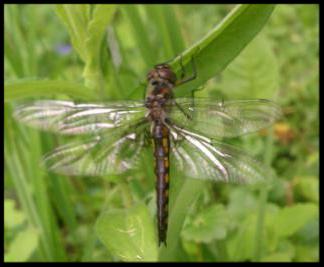 1. Dragonflies and damselflies are in the insect order called Odonata, which means "toothed ones." Many interesting characteristics set these insects apart from other groups of insects - extendable jaws under the head, small antenna, very large eyes, two pairs of transparent wings, a long and slender abdomen, and an aquatic larval (nymph) stage.
1. Dragonflies and damselflies are in the insect order called Odonata, which means "toothed ones." Many interesting characteristics set these insects apart from other groups of insects - extendable jaws under the head, small antenna, very large eyes, two pairs of transparent wings, a long and slender abdomen, and an aquatic larval (nymph) stage.
2. There are between 5,500 and 6,500 species
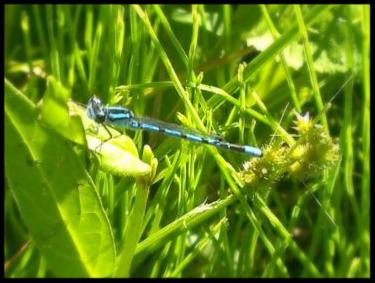
of
dragonflies and damselflies in the world, 140 being found in Minnesota. A prehistoric species that lived 250 million years ago had a 30 inch long wingspan and an 18 inch long body! The species that we have in Minnesota today are considerably smaller, with the largest being the "Lake Darner" and the "Arrowhead Spike Tail". (oh yeah, we forgot to mention dragonflies and damselflies have some pretty awesome names).
3. Dragonflies are important predators in our ecosystems. They often prey on mosquitoes, gnats, midges, moths, and other insects that can be pests to us. On a good day, a dragonfly will consume its own body weight in bugs in a half-hour! They also are an important component in food webs throughout their life cycles, being food for fish, frogs, toads, birds and other wildlife.
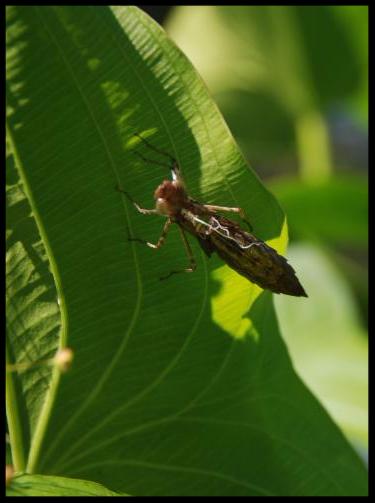 4. Their lifespans follow three stages: egg, larva (nymph), and adult. The eggs are deposited in water and the larvae hatch from the eggs. These larvae are fierce predators and eat just about anything a bit smaller than their body length. Upon maturity, larval nymphs leave the water and molt into adult dragonflies. Very often, nymphs will use emergent aquatic plants like bulrush or bur-reed to attach to and molt. The larval stage of the dragonfly can vary tremendously from months to even years but its adult life only lasts between 4-6 months. 4. Their lifespans follow three stages: egg, larva (nymph), and adult. The eggs are deposited in water and the larvae hatch from the eggs. These larvae are fierce predators and eat just about anything a bit smaller than their body length. Upon maturity, larval nymphs leave the water and molt into adult dragonflies. Very often, nymphs will use emergent aquatic plants like bulrush or bur-reed to attach to and molt. The larval stage of the dragonfly can vary tremendously from months to even years but its adult life only lasts between 4-6 months.
5. Dragonflies and damselflies are known
as
"environmental indicators" meaning their presence or lack thereof tells us something about the health of that particular area or ecosystem. Dragonfly surveys that determine the species and numbers of individuals are used to grade the health or condition of stream, river, and wetland ecosystems.
So what can we do to attract these amazing Olympic athletes of the skies? Well, if you are fortunate to live on a lake, pond, or wetland, think about adding emergent plants like bulrush, spike-rush, bur-reed, or arrowhead. These provide excellent habitat for dragonflies. (you may need a DNR permit to plant emergents - check first) Adding even a small water feature to your native landscape will attract dragonflies. Some gardeners have reported dragonfly larvae living happily in wooden half-barrels filled with rain water and a few emergent plants. Even if you are close to water, say within a half to one mile away, dragonflies will find and visit native gardens and hunt for prey. Think about adding a few wooden stakes that will act as dragonfly perches. The greater native plant diversity, the increased likelihood that you will attract these unbelievably wonderful native insects!
|
|
Native Plant of the Month
|
Hoary Vervain 
Verbena stricta
Moisture: Dry
Exposure: Full Sun or Partial Shade
Color: Purple
Bloom: June-September
Height: 1-2 Feet
Hoary Vervain is a vigorous, clump-forming, short-lived plant growing from a root system with a central taproot. It is a square-stemmed perennial covered with white hairs, giving the plant a grayish cast. Their oblong leaves are also covered with hairs; hence the name, "hoary". They have multiple upright flower stalks packed with small blue-purple tubular flowers. This plant thrives in full sun and dry to medium well-drained soils. It also adapted for good drought resistance. Found in sandy fields, dry prairies, mesic prairies, and roadsides, their flowers are visited by bees, butterflies, and wasps. Their seeds are also eaten by birds. Hoary Vervain is not generally consumed by animals like deer or rabbits since the foliage is bitter. Leaves were used by Native Americans for medicine. Other common names are woolly verbena, hairy blue vervain, hoary verbena, and mullein-leaved verbena.
|
|
Invasive Plant of the Month
|
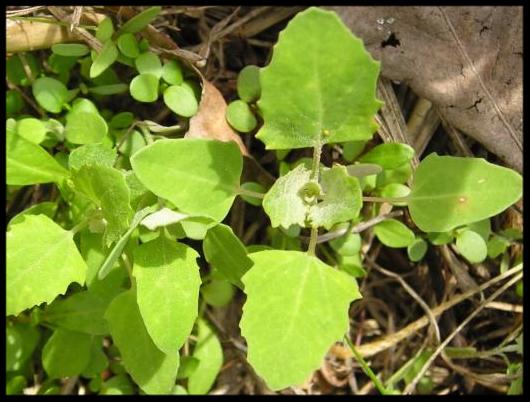
Lamb's quarters
Chenopodium album
Exposure: Full Sun/Partial Shade
Moisture: Dry
Height: 2-6 Feet
Blooms: Late spring into summer
Color: Green
Lamb's quarters is an annual invasive plant from Europe and Asia. Leaves are alternate and slightly toothed. The undersides of the leaves and stems can have a purple tinge to them. It also can have a white powdery texture on the plant as well. The flowers are found closer to the stem and are greenish white. This plant propagates by seed and can produce more than 70,000 seeds from just one plant! Management strategies include hand pulling, weed whipping heads off to prevent seeding, or select herbicide treatments. This plant is also edible!
Native plant alternatives include
Purple Prairie Clover and Heath Aster
|
Red Admiral 
Vanessa atalanta
Range: North America into Central America
Habitat: Moist areas, fields, open areas, wooded areas.
Adult Identification: Adults have dark brown/black wings with orange stripes and white dots on the upperside of the wings. Undersides of the lower wings are mottled grey and brown. There is also a red stripe, a blue stripe, and white dots on the underside of the upper wing.
Pollination: Adults feed on nectar from various native plants such as nettle, pale purple coneflower, Culver's root, Milkweed species, and others.
|
Mike Tuma 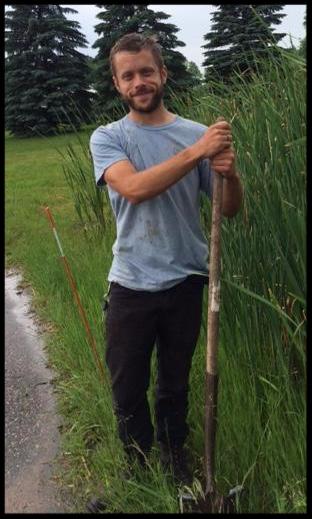
Installation Crew
Mike has joined our installation crew this year and is making a big impact on our busy spring schedule. He has wonderful native plant restoration experience from working at the Minnesota Landscape Arboretum and got his degree in Environmental Sciences, Sustainability, and Social Justice. Mike also enjoys cycling, mushroom hunting, and hiking! We are lucky to be able to add him to the Natural Shore team!
|
|
|
Our retail nursery is re-opening f
or the 2016 season! Check out sale dates below. Want to place a plant order? Contact Jill at [email protected]
Our retail nursery will be open
10am-4pm on the below dates:
June 16th
June 23rd-25th
June 30th
July 8th-9th
August 12th-13th
Click and visit our website for current
|
|
Attracting Hummingbirds:
1.Cardinal Flower (
Lobelia Cardinalis
)
Wet/Moist, Sun/Part Shade/Shade, 2-4 ft height
2. Blue Lobelia
(
Lobelia siphilitica
)
Wet/Moist, Sun/Part Shade, 1-3 ft. height
3. Columbine
(
Aquilegia canadensis
)
 Moist/Dry, Sun/Partial Shade/Full Shade, 2-3 ft. height
Moist/Dry, Sun/Partial Shade/Full Shade, 2-3 ft. height
4. Foxglove Beardtongue (
Penstemon digitalis
)
Moist/Dry, Sun/Partial Shade/Shade, 3-4 ft. height
5. Obedient Plant (
Physostegia virginiana
)
Wet/Moist, Sun/Part Shade, 2-4 ft. height
|
|
 |
|